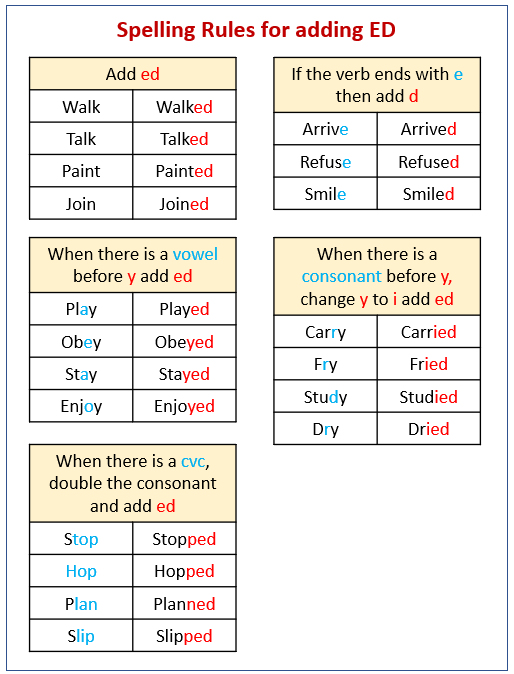Adding ED
Related Pages
Phonic Sounds
English for Kids
Videos and songs to help First Grade kids learn how to add -ed to make past tense of regular verbs. What are the spelling rules to add -ed to verbs?
What is the Past Tense?
The past tense is a verb form that indicates an action, event, or state of being that occurred in the past. It is used to talk about something that has already happened.
Simple Past Tense
The simple past tense is used for actions that were completed in the past. It is often formed by adding -ed to regular verbs. Irregular verbs, however, have unique past tense forms that must be memorized.
Learn more about Irregular Verbs
Spelling Rules when adding -ed
When adding -ed to form the past tense of regular verbs, there are specific spelling rules to follow depending on the structure of the verb.
The following diagram gives the some spelling rules for adding ED. Scroll down the page for more examples.

Spelling Rules for Verbs
Adding -ed
Irregular Verbs
Adding -ing
1. For Most Verbs
Simply add -ed to the base verb.
Examples:
work → worked
play → played
2. Verbs Ending in “e”
Add -d (do not double the “e”).
Examples:
love → loved
agree → agreed
3. Verbs Ending in Consonant + “y”
Change the “y” to “i” and add -ed.
Examples:
study → studied
cry → cried
4. Verbs Ending in Vowel + “y”
Simply add -ed without changing the “y."
Examples:
play → played
enjoy → enjoyed
5. Verbs with a Short Vowel + Consonant (CVC Pattern)
Double the final consonant before adding -ed (only for one-syllable words or stressed final syllables).
Examples:
stop → stopped
plan → planned
6. Verbs Ending in “w” or “x”
Do not double the final consonant; simply add -ed.
Examples:
show → showed
fix → fixed
7. Verbs Ending in “c”
Add -ked because “ck” maintains the hard “k” sound.
Examples:
panic → panicked
picnic → picnicked
Adding -ed to verbs
Learn why ’ed’ sends verbs into the past.
ED song
-ed means it’s all over now
Spelling rules for adding ED
Adding -ed and -ing to Short-Vowel Words
Try out our new and fun Fraction Concoction Game.
Add and subtract fractions to make exciting fraction concoctions following a recipe. There are four levels of difficulty: Easy, medium, hard and insane. Practice the basics of fraction addition and subtraction or challenge yourself with the insane level.

We welcome your feedback, comments and questions about this site or page. Please submit your feedback or enquiries via our Feedback page.